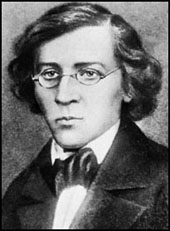<Back to Index>
- Philosopher Nikolay Gavrilovich Chernyshevsky, 1828
- Painter Eugène Boudin, 1824
- President of Argentina Juan Hipólito del Sagrado Corazón de Jesús Yrigoyen Alem, 1852
PAGE SPONSOR

Nikolay Gavrilovich Chernyshevsky (Russian: Никола́й Гаври́лович Черныше́вский) (July 12, 1828 – October 17, 1889) was a Russian revolutionary democrat, materialist philosopher, critic, and socialist (seen by some as a utopian socialist). He was the leader of the revolutionary democratic movement of the 1860s, and was an influence on Vladimir Lenin and Emma Goldman and Serbian political writer and socialist Svetozar Marković.
The son of a priest, Chernyshevsky was born in Saratov in 1828, and stayed there till 1846. After graduating from Saint Petersburg University in 1850, he taught literature at a gymnasium in Saratov. From 1853 to 1862, he lived in Saint Petersburg, and became the chief editor of Sovremennik ("Contemporary"), in which he published his main literary reviews and his essays on philosophy.
In 1862, he was arrested and confined in the Fortress of St. Peter and Paul, where he wrote his famous novel What Is to Be Done? The
novel was an inspiration to many later Russian revolutionaries, who
sought to emulate the novel's hero, who was wholly dedicated to the
revolution, ascetic in
his habits and ruthlessly disciplined, to the point of sleeping on a
bed of nails and eating only meat in order to build strength for the
Revolution. Among those who took inspiration from the character was
Lenin, who wrote a work of political theory of the same name,
and who was ascetic in his personal life (lifting weights, having
little time for love, and so on). In 1862, Chernyshevsky was sentenced
to civil execution (mock execution), followed by penal servitude (1864 - 72), and by exile to Vilyuisk, Siberia (1872 - 83). He died at the age of 61. Chernyshevsky was a founder of Narodism, Russian populism,
and agitated for the revolutionary overthrow of the autocracy and the
creation of a socialist society based on the old peasant commune. Chernyshevsky's ideas were heavily influenced by Alexander Herzen, Vissarion Belinsky, and Ludwig Andreas Feuerbach. He saw class struggle as
the means of society's forward movement and advocated for the interests
of the working people. In his view, the masses were the chief maker of
history. He is reputed to have used the phrase "the worse the better",
to indicate that the worse the social conditions became for the poor,
the more inclined they would be to launch a revolution. According to Professor Emeritus of Slavic and Comparative Literature at Stanford, Joseph Frank, "Chernyshevsky's novel What Is to Be Done?, far more than Marx's Capital, supplied the emotional dynamic that eventually went to make the Russian Revolution".